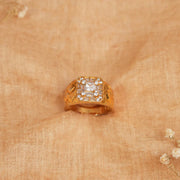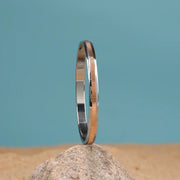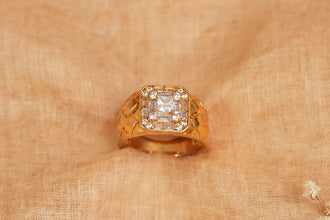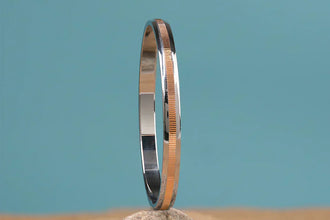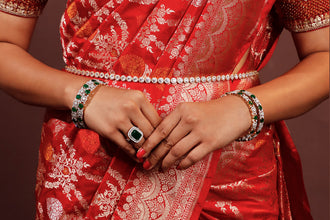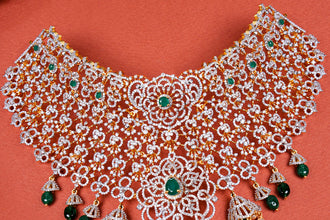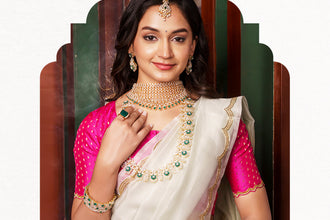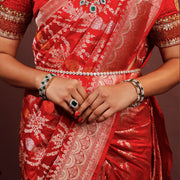
An engagement ring means much more than a piece of jewellery - it’s a lasting emblem of love, commitment, and the shared future between two people. For those who choose silver, a metal admired for its understated elegance, affordability, and timeless charm, the decision of which hand to wear it on becomes both personal and meaningful.
This decision is determined by tradition, culture, lifestyle and comfort. There is a wealth of knowledge to be gained with the help of Padmam, which boasts years of experience in fine silver jewellery. With the guidance of this brand, let's explore together the fascinating traditions and contemporary ideas of wearing your silver engagement ring.
Traditional Hand of Engagement Rings
In many Western countries, including the United Kingdom, the engagement ring is worn on the left ring finger. This tradition goes back to ancient Rome, where it was considered that vena amoris, the ” vein of love”, flowed straight towards the heart using this finger.
However, this is not a universal rule. Around the world, some cultures wear engagement rings on the right hand, either before marriage or for life, depending on local customs.
Right Hand vs Left Hand - What It Means
The choice of hand can reflect:
-
Cultural heritage – In some societies, the right hand symbolises honour, loyalty, or marital commitment.
-
Religious beliefs – Certain faith traditions prescribe a specific hand for engagement or wedding rings.
-
Practicality – Some left-handed people prefer wearing rings on the right hand to prevent damage during daily activities.
As Padmam often advises clients, there’s no single “correct” answer — it’s a blend of symbolism, family tradition, and personal comfort.
Engagement Ring Customs Around the World
-
United Kingdom & Ireland – Worn on the left hand, both before and after the wedding.
-
United States, Canada, Australia, New Zealand – Worn on the left hand, following UK tradition.
-
Germany, Russia, Norway, Denmark – Worn on the right hand; may be moved to the left after marriage.
-
India – Varies by region; the right hand is used in some areas due to cultural beliefs, while the left hand is used in urban areas influenced by Western customs.
-
Brazil – Worn on the right hand before marriage, then switched to the left after the wedding.
Padmam’s Perspective on Ring Placement
According to Padmam, “Engagement ring placement is one of the most enduring traditions in jewellery. In the Western world, the left hand reflects romance and sentiment, but in Eastern Europe and parts of Asia, the right hand carries deep connotations of power, honour, and faith.”
Whether you wear your sterling silver engagement ring on the left or right hand, the choice often tells a story - about heritage, identity, and the meaning you attach to your commitment.
Wearing Engagement and Wedding Rings Together
The wedding ring is typically the most cherished, followed by the engagement ring on top of it. But in the present-day marriage, partners have accepted flexibility:
-
Putting both rings on one finger.
-
On one hand, one ring.
-
Swapping up rings between events.
If your engagement ring is crafted from silver, pairing it with a silver wedding band creates an elegant, harmonious set — something Padmam’s master jewellers excel at designing.
How to Decide Which Hand Is Right for You
When choosing, consider:
-
Family tradition – Does your heritage suggest a preferred hand?
-
Comfort – Which feels natural for daily wear?
-
Lifestyle – Do you work with your hands or in environments where the ring could be damaged?
-
Symbolism – Which side carries the meaning you value most?
Symbolism of a Silver Engagement Ring
Silver has long been a cherished metal in engagement jewellery for both its beauty and its deeper meaning:
-
Purity – Its bright, reflective surface is linked to sincerity and truth.
-
Power - Silver is powerful, despite its softness in appearance, as it is symbolic of strength in love.
-
Peace - Many cultures associate silver with the calmness of the soul.
Engagement ring, which is in silver, and Padmam is not an ordinary omen about your union, but it is an heirloom coming to being.
Contemporary Ring-Wearing Preferences
Although history continues to exert its impact on our traditions, couples nowadays are paving a new way:
-
Some swap hands after the wedding.
-
Some keep only the engagement ring as their daily symbol of commitment.
-
Minimalists may opt for a single silver ring to act as both an engagement and a wedding ring.
To even more appropriately quote Padmam, the real belonging of an engagement ring is not in the hand but instead in the heart.
Final Thoughts
Which hand to wear your silver engagement ring is more or less about the rules, rather than the meaning. No matter which direction you decide to go -classic left-hand, right-hand custom, or design your own -the decision should take into consideration your love story and lifestyle.
When that ring is from Padmam, you carry not just a symbol of your relationship but also the legacy of craftsmanship that will endure for generations.
FAQ
1. Which hand should I wear my engagement ring on?
In most Western countries, it’s worn on the left ring finger. In countries like Germany and Brazil, the right hand is traditionally used.
2. Is it acceptable to wear it on the right hand?
Yes. Cultural, religious, or personal reasons often influence this choice.
3. Can I wear my wedding and engagement rings together?
Traditionally, yes — the wedding ring is worn first, followed by the engagement ring. But many choose to wear them separately or switch between them.
4. Why is the fourth finger called the ring finger?
The name originates from the ancient belief that a vein in this finger is believed to connect directly to the heart.


